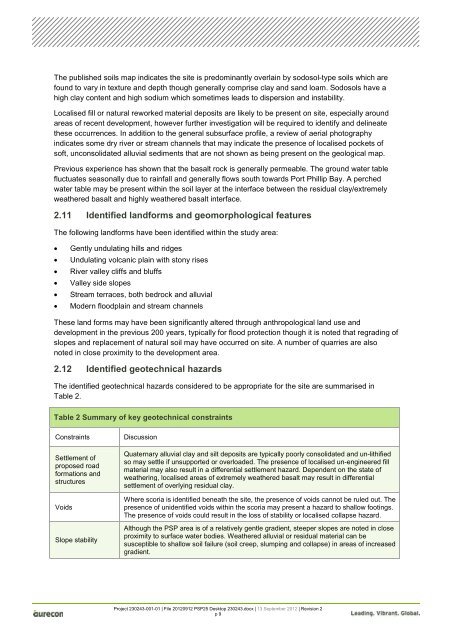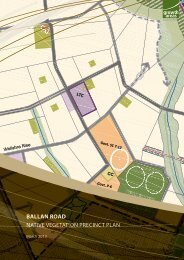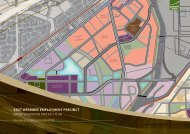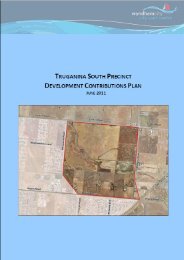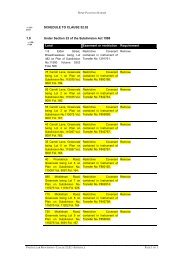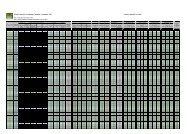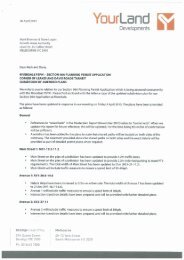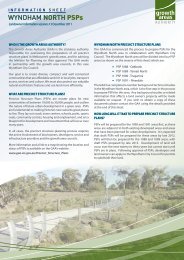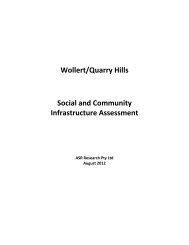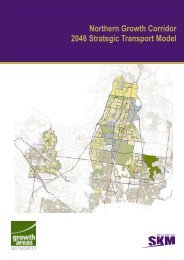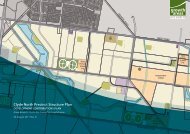Desktop Environmental, Hydrological and Geotechnical Study
Desktop Environmental, Hydrological and Geotechnical Study
Desktop Environmental, Hydrological and Geotechnical Study
You also want an ePaper? Increase the reach of your titles
YUMPU automatically turns print PDFs into web optimized ePapers that Google loves.
The published soils map indicates the site is predominantly overlain by sodosol-type soils which are<br />
found to vary in texture <strong>and</strong> depth though generally comprise clay <strong>and</strong> s<strong>and</strong> loam. Sodosols have a<br />
high clay content <strong>and</strong> high sodium which sometimes leads to dispersion <strong>and</strong> instability.<br />
Localised fill or natural reworked material deposits are likely to be present on site, especially around<br />
areas of recent development, however further investigation will be required to identify <strong>and</strong> delineate<br />
these occurrences. In addition to the general subsurface profile, a review of aerial photography<br />
indicates some dry river or stream channels that may indicate the presence of localised pockets of<br />
soft, unconsolidated alluvial sediments that are not shown as being present on the geological map.<br />
Previous experience has shown that the basalt rock is generally permeable. The ground water table<br />
fluctuates seasonally due to rainfall <strong>and</strong> generally flows south towards Port Phillip Bay. A perched<br />
water table may be present within the soil layer at the interface between the residual clay/extremely<br />
weathered basalt <strong>and</strong> highly weathered basalt interface.<br />
2.11 Identified l<strong>and</strong>forms <strong>and</strong> geomorphological features<br />
The following l<strong>and</strong>forms have been identified within the study area:<br />
• Gently undulating hills <strong>and</strong> ridges<br />
• Undulating volcanic plain with stony rises<br />
• River valley cliffs <strong>and</strong> bluffs<br />
• Valley side slopes<br />
• Stream terraces, both bedrock <strong>and</strong> alluvial<br />
• Modern floodplain <strong>and</strong> stream channels<br />
These l<strong>and</strong> forms may have been significantly altered through anthropological l<strong>and</strong> use <strong>and</strong><br />
development in the previous 200 years, typically for flood protection though it is noted that regrading of<br />
slopes <strong>and</strong> replacement of natural soil may have occurred on site. A number of quarries are also<br />
noted in close proximity to the development area.<br />
2.12 Identified geotechnical hazards<br />
The identified geotechnical hazards considered to be appropriate for the site are summarised in<br />
Table 2.<br />
Table 2 Summary of key geotechnical constraints<br />
Constraints Discussion<br />
Settlement of<br />
proposed road<br />
formations <strong>and</strong><br />
structures<br />
Voids<br />
Slope stability<br />
Quaternary alluvial clay <strong>and</strong> silt deposits are typically poorly consolidated <strong>and</strong> un-lithified<br />
so may settle if unsupported or overloaded. The presence of localised un-engineered fill<br />
material may also result in a differential settlement hazard. Dependent on the state of<br />
weathering, localised areas of extremely weathered basalt may result in differential<br />
settlement of overlying residual clay.<br />
Where scoria is identified beneath the site, the presence of voids cannot be ruled out. The<br />
presence of unidentified voids within the scoria may present a hazard to shallow footings.<br />
The presence of voids could result in the loss of stability or localised collapse hazard.<br />
Although the PSP area is of a relatively gentle gradient, steeper slopes are noted in close<br />
proximity to surface water bodies. Weathered alluvial or residual material can be<br />
susceptible to shallow soil failure (soil creep, slumping <strong>and</strong> collapse) in areas of increased<br />
gradient.<br />
Project 230243-001-01 | File 20120912 PSP25 <strong>Desktop</strong> 230243.docx | 13 September 2012 | Revision 2<br />
p 9


